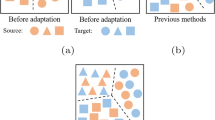Abstract
Generating models to handle new visual tasks requires additional datasets, which take considerable effort to create. We propose a method of domain adaptation for merging multiple models with less effort than creating an additional dataset. This method merges pre-trained models in different domains using glue layers and a generative model, which feeds latent features to the glue layers to train them without an additional dataset. We also propose a generative model that is created by distilling knowledge from pre-trained models. This enables the dataset to be reused to create latent features for training the glue layers. We apply this method to object detection in a low-light situation. The YOLO-in-the-Dark model comprises two models, Learning-to-See-in-the-Dark model and YOLO. We present the proposed method and report the result of domain adaptation to detect objects from RAW short-exposure low-light images. The YOLO-in-the-Dark model uses fewer computing resources than the naive approach.
Access this chapter
Tax calculation will be finalised at checkout
Purchases are for personal use only
Similar content being viewed by others
References
Chang, W.G., You, T., Seo, S., Kwak, S., Han, B.: Domain-specific batch normalization for unsupervised domain adaptation. In: CVPR 2019 (2019)
Chen, C., Chen, Q., Xu, J., Koltun, V.: Learning to see in the dark. In: CVPR 2018 (2018)
Chen, G., Choi, W., Yu, X., Han, T., Chandraker, M.: Learning efficient object detection models with knowledge distillation. In: Advances in Neural Information Processing Systems 30, pp. 742–751 (2017)
Everingham, M., Gool, L.V., Williams, C., Winn, J., Zisserman, A.: The PASCAL visual object classes challenge 2012 (VOC2012) results. In: VOC 2012 (2012)
Hinton, G., Vinyals, O., Dean, J.: Distilling the knowledge in a neural network (2015). arXiv:1503.02531
Krizhevsky, A., Sutskever, I., Hinton, G.: Imagenet classification with deep convolutional neural networks. In: Proceedings of the Advances Neural Information Processing Systems 25 (NIPS), pp. 1097–1105 (2012)
Lin, T.Y., et al.: Microsoft coco: common objects in context (2014). arXiv:1405.0312
Loh, Y.P., Chan, C.S.: Getting to know low-light images with the exclusively dark dataset. Comput. Vis. Image Underst. 178, 30–42 (2019). https://doi.org/10.1016/j.cviu.2018.10.010
Luo, J., Xu, Y., Tang, C., Lv, J.: Learning inverse mapping by autoencoder based generative adversarial nets (2017). arXiv:1703.10094
Redmon, J., Divvala, S., Girshick, R., Farhadi, A.: You only look once: unified, real-time object detection. In: CVPR 2016 (2016)
Redmon, J., Farhadi, A.: Yolov3: an incremental improvement (2018). arXiv:1804.02767
Romero, A., Ballas, N., Kahou, S.E., Chassang, A., Gatta, C., Bengio, Y.: Fitnets: hints for thin deep nets (2014). arXiv:1412.6550
Ronneberger, O., Fischer, P., Brox, T.: U-net: convolutional networks for biomedical image segmentation. In: MICCAI (2015)
Teng, Y., Choromanska, A., Bojarski, M.: Invertible autoencoder for domain adaptation (2018). arXiv:1802.06869
Xie, S., Zheng, Z., Chen, L., Chen, C.: Learning semantic representations for unsupervised domain adaptation. In: ICML 2018 (2018)
Author information
Authors and Affiliations
Corresponding author
Editor information
Editors and Affiliations
Rights and permissions
Copyright information
© 2020 Springer Nature Switzerland AG
About this paper
Cite this paper
Sasagawa, Y., Nagahara, H. (2020). YOLO in the Dark - Domain Adaptation Method for Merging Multiple Models. In: Vedaldi, A., Bischof, H., Brox, T., Frahm, JM. (eds) Computer Vision – ECCV 2020. ECCV 2020. Lecture Notes in Computer Science(), vol 12366. Springer, Cham. https://doi.org/10.1007/978-3-030-58589-1_21
Download citation
DOI: https://doi.org/10.1007/978-3-030-58589-1_21
Published:
Publisher Name: Springer, Cham
Print ISBN: 978-3-030-58588-4
Online ISBN: 978-3-030-58589-1
eBook Packages: Computer ScienceComputer Science (R0)




